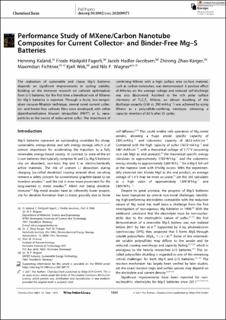| dc.contributor.author | Kaland, Henning | |
| dc.contributor.author | Fagerli, Frode Håskjold | |
| dc.contributor.author | Hadler-Jacobsen, Jacob | |
| dc.contributor.author | Zhao-Karger, Zhirong | |
| dc.contributor.author | Fichtner, Maximilian | |
| dc.contributor.author | Wiik, Kjell | |
| dc.contributor.author | Wagner, Nils Peter | |
| dc.date.accessioned | 2022-02-07T15:29:46Z | |
| dc.date.available | 2022-02-07T15:29:46Z | |
| dc.date.created | 2021-02-14T21:11:25Z | |
| dc.date.issued | 2021 | |
| dc.identifier.citation | ChemSusChem. 2021, 14 1864-1873. | en_US |
| dc.identifier.issn | 1864-5631 | |
| dc.identifier.uri | https://hdl.handle.net/11250/2977582 | |
| dc.description.abstract | The realization of sustainable and cheap Mg-S batteries depends on significant improvements in cycling stability. Building on the immense research on cathode optimization from Li-S batteries, for the first time a beneficial role of MXenes for Mg-S batteries is reported. Through a facile, low-temperature vacuum-filtration technique, several novel current collector- and binder-free cathode films were developed, with either dipenthamethylene thiuram tetrasulfide (PMTT) or S8 nanoparticles as the source of redox-active sulfur. The importance of combining MXene with a high surface area co-host material, such as carbon nanotubes, was demonstrated. A positive effect of MXenes on the average voltage and reduced self-discharge was also discovered. Ascribed to the rich polar surface chemistry of Ti3C2Tx MXene, an almost doubling of the discharge capacity (530 vs. 290 mA h g−1) was achieved by using MXene as a polysulfide-confining interlayer, obtaining a capacity retention of 83 % after 25 cycles. | en_US |
| dc.language.iso | eng | en_US |
| dc.publisher | Wiley | en_US |
| dc.rights | Navngivelse 4.0 Internasjonal | * |
| dc.rights.uri | http://creativecommons.org/licenses/by/4.0/deed.no | * |
| dc.subject | Nanoteknologi | en_US |
| dc.subject | Nanotechnology | en_US |
| dc.subject | Batteriteknologi | en_US |
| dc.subject | Battery technology | en_US |
| dc.title | Performance Study of MXene/Carbon Nanotube Composites for Current Collector- and Binder-Free Mg-S Batteries | en_US |
| dc.type | Peer reviewed | en_US |
| dc.type | Journal article | en_US |
| dc.description.version | publishedVersion | en_US |
| dc.subject.nsi | VDP::Funksjonelle materialer: 522 | en_US |
| dc.subject.nsi | VDP::Functional materials: 522 | en_US |
| dc.source.pagenumber | 1864-1873 | en_US |
| dc.source.volume | 14 | en_US |
| dc.source.journal | ChemSusChem | en_US |
| dc.identifier.doi | 10.1002/cssc.202100173 | |
| dc.identifier.cristin | 1889652 | |
| dc.relation.project | Norges forskningsråd: 275810 | en_US |
| cristin.ispublished | true | |
| cristin.fulltext | original | |
| cristin.qualitycode | 1 | |

